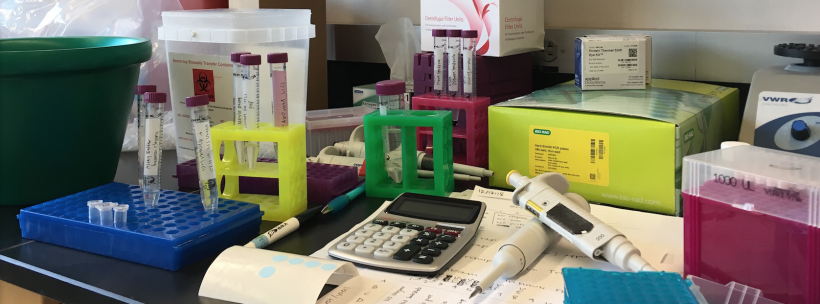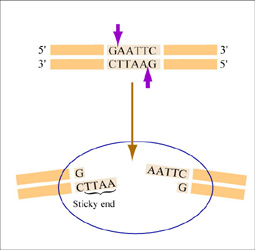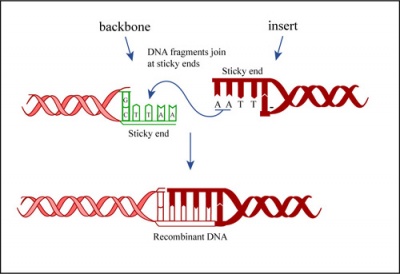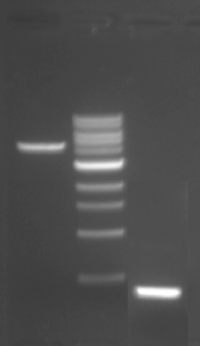20.109(S19):In silico cloning and confirmation digest of protein expression vector(Day1)
Contents
Introduction
Though the theme of Module 1 is focused on a small molecule screen to understand protein interactions, today will focus on a few key techniques used in DNA engineering. Because the sequence of proteins is determined by the sequence of the genes that encode them, learning how to manipulate DNA is an important first step. Today you will complete a virtual cloning reaction to generate a protein expression vector that contains the gene that encodes FKBP12, a member of a protein family involved in protein folding for sequences that contain prolines. The cloning schematic is illustrated in the schematic below.

The cloning vector we will use is pET21. This vector has several features that make it ideal for cloning and protein expression -- both of which are important for this module. We will discuss the FKBP12 protein in much more detail later, for now it is sufficient to know that it is encoded by a 324-basepair sequence. To generate your final product you will use three common DNA engineering techniques: PCR amplification, restriction enzyme digestion, and ligation.
PCR amplification
The applications of PCR (polymerase chain reaction) are widespread, from forensics to molecular biology to evolution, but the goal of any PCR is the same: to generate many copies of DNA from a single or a few specific sequence(s) (called the “target” or “template”).
In addition to the target, PCR requires only three components: primers to bind sequence flanking the target, dNTPs to polymerize, and a heat-stable polymerase to carry out the synthesis reaction over and over and over. DNA polymerases require short initating pieces of DNA (or RNA) called primers in order to copy DNA. In PCR amplification, forward and reverse primers that target the non-coding and coding strands of DNA, respectively, are separated by a distance equal to the length of the DNA to be copied. Length is one important design feature. Primers that are too short may lack requisite specificity for the desired sequence, and thus amplify an unrelated sequence. The longer a primer is, the more favorable are its energetics for annealing to the template DNA, due to increased hydrogen bonding. On the other hand, longer primers are more likely to form secondary structures such as hairpins, leading to inefficient template priming. Two other important features are G/C content and placement. Having a G or C base at the 3'-end of each primer increases priming efficiency, due to the greater energy of a GC pair compared to an AT pair. The latter decrease the stability of the primer-template complex. Overall G/C content should ideally be 50 +/- 10%, because long stretches of G/C or A/T bases are both difficult to copy. The G/C content also affects the melting temperature. PCR is a three-step process (denature, anneal, extend) and these steps are repeated 20 or more times. After 30 cycles of PCR, there could be as many as a billion times more copies of the original target sequence.
Based on the numerous applications of PCR, it may seem that the technique has been around forever. In fact it is just over 30 years old. In 1984, Kary Mullis described this technique for amplifying DNA of known or unknown sequence, realizing immediately the significance of his insight.
"Dear Thor!," I exclaimed. I had solved the most annoying problems in DNA chemistry in a single lightening bolt. Abundance and distinction. With two oligonucleotides, DNA polymerase, and the four nucleosidetriphosphates I could make as much of a DNA sequence as I wanted and I could make it on a fragment of a specific size that I could distinguish easily. Somehow, I thought, it had to be an illusion. Otherwise it would change DNA chemistry forever. Otherwise it would make me famous. It was too easy. Someone else would have done it and I would surely have heard of it. We would be doing it all the time. What was I failing to see? "Jennifer, wake up. I've thought of something incredible." --Kary Mullis from his Nobel lecture; December 8, 1983
Restriction enzyme digest
Restriction endonucleases, also called restriction enzymes, 'cut' or 'digest' DNA at specific sequences of bases. The restriction enzymes are named according to the prokaryotic organism from which they were isolated. For example, the restriction endonuclease EcoRI (pronounced “echo-are-one”) was originally isolated from E. coli giving it the “Eco” part of the name. “RI” indicates the particular version on the E. coli strain (RY13) and the fact that it was the first restriction enzyme isolated from this strain.
The sequence of DNA that is bound and cleaved by an endonuclease is called the recognition sequence or restriction site. These sequences are usually four or six base pairs long and palindromic, that is, they read the same 5’ to 3’ on the top and bottom strand of DNA. For example, the recognition sequence for EcoRI is below (see also figure at right). EcoRI cleaves the phosphate backbone of DNA between the G and A of the recognition sequence, which generates overhangs or 'sticky ends' of double-stranded DNA.
5’ GAATTC 3’
3’ CTTAAG 5’
Unlike EcoRI, some other restriction enzymes cut precisely in the middle of the palindromic DNA sequence, thus leaving no overhangs after digestion. The single-stranded overhangs resulting from DNA digestion by enzymes such as EcoRI are called sticky ends, while double-stranded ends resulting from digestion by enzymes such as HaeIII are called blunt ends. HaeIII recognizes
5’ GGCC 3’
3’ CCGG 5’
Ligation
In a ligation reaction, DNA ends are covalently attached to one another via the ligase enzyme. The efficiency of the reaction is related to type of DNA ends: compatible sticky ends will ligate more efficiently than blunt ends, and non-compatible sticky ends will not be ligated due to the lack of hydrogen bonding between the basepairs. To initiate the ligation reaction, hydrogen bonds are formed between the compatible overhangs of DNA fragments. The ligase enzyme then forms a covalent phosphodiester bond between the 3' hydroxyl end of the 'acceptor' nucleotide and the 5' phosphodiester end of the 'donor' nucleotide.
The first step in this process is the addition of AMP (adenylation) to a lysine residue within the active site of DNA ligase, which releases a pyrophosphate. Next, the AMP is transferred to the 5' phosphate of the donor nucleotide resulting in the formation of a pyrophosphate bond. Lastly, a phosphodiester bond is formed between the 5' phosphate of the donor nucleotide and the 3' hydroxyl of the 3' acceptor nucleotide.
Protocols
Part 1: Laboratory orientation quiz
Complete the orientation quiz with your partner. Though you are working with your partner, each student should record all answers on the provided quiz. If you disagree with your partner on an answer, you should write what you think is the correct answer on your quiz.
Good luck!
Part 2: Construct pET21_FKBP12 in silico
For timing reasons, you will be provided with the pET21_FKBP12 product that was cloned by researchers in the Koehler Laboratory. In this exercise you will virtually work through the cloning steps that were used to ligate the FKBP12 gene into the pET21 expression vector. You can use any DNA manipulation software you choose to complete the protocols, but the instructions provided are for APE (A Plasmid Editor, created by M. Wayne Davis at the University of Utah). The software can be downloaded free-of-charge from this site onto your personal computer or you can use the 20.109 laboratory computers. Please note that if you use a different program the teaching faculty may not be able to assist you.
Be sure to document your work and answer all questions in your lab notebook as you progress through the exercises below.
Part 2a: PCR amplification and restriction enzyme digest of FKBP12 insert
To amplify a specific sequence of DNA, you first need to design primers -- one primer that anneals at the start of the sequence of interest and a second primer that anneals at the end of the sequence of interest. Today you will design a 'forward' primer that anneals to the non-coding DNA strand and reads toward the FKBP12 gene and a 'reverse' primer that anneals to the coding DNA strand at the end of the FKBP12 gene and reads back into it. Each primer will consist of two parts: the 'landing sequence' will anneal to the sequence of interest and the 'flap sequence' will be used to add DNA sequence(s) to your FKBP12 insert.
Before you begin the steps listed below, watch the following video linked here to review the details of PCR.
- Find the FKBP12 insert sequence here.
- Open APE then copy and paste the sequence into a new workspace.
- Record the size of the FKBP12 gene in your notebook.
- Because we want to amplify the entire gene, the landing sequence of the forward primer will begin with the first basepair of the sequence.
- Record the first 20 basepairs of the FKBP12 gene sequence in your notebook.
- Several websites are available to help you evaluate the characteristics of your primer. We will use the OligoAnalyzer Tool provided by Integrated DNA Technologies (IDT) linked here.
- To use this tool, you will first need to create an account.
- Once you are logged into the IDT site, click the 'Tools' dropdown from the banner at the top of the screen, then select 'OligoAnalyzer Tool' from the options.
- Copy and paste the 20 basepair sequence into Sequence box.
- Leave the defaults for stems and loops as they are and then click Analyze.
- Use the following guidelines to evaluate your primer:
- length: 17-28 basepairs
- GC Content: 50-60%
- Tm: 60-65 °C
- avoid hairpins, complementation between primers, and repetitive sequences
- If you primer does not fit the guidelines provided above, try altering the length. Remember that the 5’ end of the landing sequence must not change or you will delete basepairs from your gene.
- When you are satisfied with the landing sequence, use the Features tool to label the forward primer sequence on your APE file (Features → New Feature).
- Now that you have your landing sequence you will add a flap sequence that introduces a restriction enzyme recognition sequence.
- Consider the order in which the landing sequence and restriction enzyme site should occur in your primer and draw a schematic that shows the order of the sequences that will be incorporated into your primer then use the following steps to generate your primer sequence.
- As shown in the schematic of our cloning strategy, we need to add an NdeI recognition sequence to our forward primer. Search the NEB catalog to find the NdeI recognition sequence. Record the recognition sequence and the cleavage sites within the sequence.
- Add the recognition sequence for the NdeI restriction enzyme to the landing sequence. Consider the direction in which PCR amplification occurs to determine which end of your primer should carry the flap sequence.
- In addition to the recognition sequence, it is important to include a 6 basepair 'tail' or 'junk' sequence to ensure the restriction enzyme is able to bind and cleave the DNA. Learn more about why this is necessary from scientists at NEB. Add any sequence of 6 basepairs to your primer flap sequence. Carefully consider where this sequence should appear in your primer.
- Record the sequence (5' → 3') of your forward primer in your notebook.
- Use steps 2-5 to design your reverse primer. Please keep the following notes in mind:
- Because you want to amplify the entire gene you should start with the last basepair of the sequence.
- You will add an XhoI restriction recognition site to your reverse primer.
- Remember that the reverse primer anneals to the coding DNA strand at the end of the FKBP12 gene and reads back into it. Keep this in mind when you add the flap sequence and when you record the sequence (5' → 3') of your primer in your notebook.
- Create a new APE file that depicts the FKBP12 product you would expect if you used your primers in a PCR amplification reaction.
- What is the size of your PCR product? How does this compare to the size of the gene you recorded in Step #1.
- Add the sequence information to your notebook (it may be easiest to screen capture your work station in APE and embed the image in your notebook).
- Now that you have your amplified FKBP12 insert, you need to digest with NdeI and XhoI to generate 'sticky ends' that will enable you to ligate your insert into the pET21 vector.
- Create another new APE file that depicts your amplified FKBP12 product following a NdeI and XhoI double-digest.
- What is the size of your digest product? How does this compare to the size of your PCR product?
Part 2b: Restriction enzyme digest of pET21 vector
To prepare for the ligation step, it is important to generate compatible 'sticky ends' on the insert and vector. Above, you digested your FKBP12 amplicon (PCR amplification product) with NdeI and XhoI in a double-digest. Here you will digest your pET21 vector to create compatible ends that can be ligated together.
- Find the pET21 vector sequence here.
- Copy and paste the vector sequence into a new APE workspace.
- Commercially available cloning vectors are engineered to contain a Multiple Cloning Site (MCS). The MCS is a short segment of DNA that encodes several restriction enzyme recognition sites. These restriction enzyme recognition sites are provided for so researchers can clone their genes of interest into a specific location of the vector.
- Using the Feature tool, label basepairs 158-238 as the MCS.
- To locate the NdeI and XhoI recognition sequences within the MCS, go to Enzymes → Enzyme selector.
- Select EcoRI and click Graphic Map. An image of the plasmid should appear in a separate window with the recognition sites marked. In addition, the recognition sequences should be highlighted in the sequence that is in your workspace.
- Using the feature tool, label the NdeI and XhoI recognition sequences.
- Save your labelled pET21 file.
Part 2c: Ligation of FKBP12 insert and pET21 vector
When you complete a ligation at the bench, one very important step is to calculate the amounts of DNA you will use in the reaction. Use the steps below to calculate the amount of FKBP12 insert and pET21 vector you would use to complete this ligation in the laboratory.
- The concentrations for the insert and vector were measured using a nanodrop.
- FKPB12 insert = 20 ng/uL
- pET21 expression vector = 40 ng/uL
- Convert the mass concentration to a molar concentration, using the fact that a typical DNA base is 660 g/mol. This conversion will mostly cancel out between the insert and the backbone, except for the difference in number of bases. Feel free to either omit steps that will cancel if you are comfortable doing so, or to keep them if you follow the math better that way.
- Ideally, you will use 50-100 ng of backbone in the this ligation.
- Referring to the mass concentration, what volume of DNA will this amount require?
- Ideally, you will use a 4:1 molar ratio of insert to backbone.
- Referring to the molar concentrations, how much insert do you need per μL of backbone?
- A 15 μL scale ligation should not include more than 13.5 μL of DNA because you must leave enough volume to add buffer and the ligase enzyme.
- If your backbone and insert volumes total to greater than this amount, you must (1) scale down both DNA amounts, using less than 50 ng backbone and/or (2) stray from the ideal 4:1 molar ratio. You may ask the teaching faculty for advice during class if you are unsure what choice is best.
- Be sure to record all of your work for the ligation calculations in your notebook.
- Feel free to take a picture of your hand-written work and embed the image in your notebook.
- Next you will complete this ligation in silico to generate a plasmid map of your pET21_FKBP12 plasmid.
- To ligate your FKBP12 fragment into your pET21 vector, copy the digested FKBP12 sequence you generated above and paste it into your vector sequence.
- Recall where NdeI and XhoI cut within their recognition sequences as you consider the exact basepairs between which you should paste your FKBP12 insert.
- Hint: the FKBP12 insert should be flanked by intact NdeI and XhoI recognition sequences in your final cloning product.
- Save the file of your pET21_FKBP12 and embed the plasmid map image in your notebook.
- Now that you have generated your pET21_FKBP12 clone, discuss the following questions with your partner and record your answers in your notebook.
- Why did you use two different restriction enzymes in the cloning strategy?
- How might you ensure your cloning strategy was successful (ie how can you confirm the product)?
Part 3: Confirmation digest
To confirm cloning products, researchers complete 'diagnostic' or 'confirmation' digests. Recall from the prelab lecture that this step is important as a control -- you want to be sure that the products you use in your research are correct. This is an important step to check products you clone yourself and, perhaps more importantly, those that you may receive from another researcher.
Ideally you will use a single enzyme that cuts once within the vector and once within your insert. Unfortunately, this is rarely an option and you instead need to select an enzyme that cuts once within the vector and a second, compatible enzyme that cuts once within the insert. Enzyme compatibility is determined by the buffer. If two enzymes are able to function (cleave DNA) in the same buffer, they are compatible. The NEB double digest online tool will prove very helpful!
Use the 20.109 list of enzymes, information from the lab manual and the plasmid map you generated above to choose the enzymes you will use. Use this file to view the pET21 vector with the FKBP12 insert already ligated into it. The FKBP12 insert occurs from base 5202 to 5567.
The following table may be helpful as you plan your work. Each column corresponds to one eppendorf tube, containing the pET21_FKBP12 plasmid, the appropriate enzymes, and buffer at the correct concentration (final concentration at 1x). Note that if you only use one enzyme you will only need two columns instead of four.
Keep the following in mind as you consider which enzymes to use:
- Each enzyme should be present in 10 U quantity. As an example, the XbaI vial contains 20,000 U/mL, or 20 U/μL, therefore one reaction will require 0.5 μL.
- Because the lower limit of your P20 pipet is 2.0 μL, you may need to use the P2 at the front bench for smaller volumes.
- Enzyme volume should not exceed 10% of the total reaction volume to prevent star activity due to excess glycerol.
- The 20.109 enzyme stocks are always the "S" size and concentration.
| Diagnostic digest | Enzyme 1 only | Enzyme 2 only | No enzyme (uncut) | |
|---|---|---|---|---|
| pET21_FKBP12 | 5 μL | 5 μL | 5 μL | 5 μL |
| 10X NEB buffer | ____μL of buffer#_____ | ____μL of buffer#_____ | ____μL of buffer#_____ | ____μL of buffer#_____ |
| 1st Enzyme (10 U) in 1x Buffer | ____ μL of _____ | ____ μL of _____ | ||
| 2nd Enzyme (10 U) in 1x Buffer | ____ μL of _____ | ____ μL of _____ | ||
| H2O | to a final volume of 25 μL | |||
- Unlike the cloning steps you completed above, the diagnostic digest will be performed at the benchtop.
- Clearly label four eppendorf tubes, including the plasmid name, the enzymes to be added, and your team color.
- Aliquot 5 μL of pET21_FKBP12 into each of the four tubes
- Based on your calculations in the table above, add the appropriate volumes of water, buffer, and enzyme, such that the final volume in each tube is 25 μL.
- Flick the tubes to mix the contents then gather the liquid in the bottom of the tube with a short spin down.
- Incubate your digests at 37 °C.
The teaching faculty will leave your digests at 37°C overnight, then move them to -20°C.
Reagents
- Restriction enzymes (NEB)
- pET21_FKBP12 plasmid, concentration = 100 ng/uL (gift from the Koehler lab)
- Isopropyl β-D-1-thiogalactopyranoside, IPTG (Sigma)
- L(+)Arabinose (Sigma)
Next day: Purify protein for secondary assays







